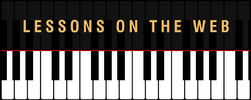|
Key signatures in music are similar to grammar rules in language studies. They tell us exactly which notes we need to play and whether specific notes need to be sharp or flat. The number of sharps and/or flats tells us what Key Signature we’re playing in. Today we’re going to learn how to identify a Key by what sharps or flats are listed in the key signature of a piece as well as learn how to look at a specific Key and know exactly what the sharps or flats are in that Key. First, we need to review what the order of sharps and flats are. They will always be noted in the key signature according to this same order. Sharps: F, C, G, D, A, E, B Flats: B, E, A, D, G, C, F Remember as a beginning student and you first saw a sharp in the Key Signature of a piece? The first sharp is F# and it is usually the first sharp we learn to play and read in music. This is the key of G Major. Every time we learn a new key we add in another sharp according to the order listed above. It’s the same with flats. Anytime you see a key signature in the beginning of a piece, you will read the sharps or flats in this same order. Knowing the order ahead of time really helps you quickly name them as soon as you seem them in your piece.
Next, let’s look at how we can figure out what Key our piece is in by simply looking at the Key Signature. It’s a bit easier with flats, so we’ll start there. All you have to do is look at the next to the last flat listed, or the one all the way to the right in the Key Signature, and that is the name if the Key of the piece. For example, if we have 3 flats listed in the key signature, and we know by the order of flats that they will be Bb, Eb & Ab…we simply look at the next to the last flat which is Eb in this case, and there we have the name of the key we’re playing in – Eb.
Sharps work differently and have one more step added in. With sharps, you go to the very last sharp, or the one all the way to the right. Next, move up one ½ step, and the note you land on is the name of the key of the piece. This works even with one sharp in the key signature. We know from our order of sharps that the first sharp is F#. To find the name of the Key that has just F# in it, move up one ½ step and we land on the note G. So…we are in the key of G Major in this case.
Now let’s learn how you can identify what sharps or flats are in a given key signature when we can’t see the actual key signature on the page of sheet music. (This happens a lot for those who play with bands and do improv work). If you need to figure out a specific key signature that has sharps in it, simply start on the note that is the name of the Key…for example, the key of E. Start at the note E on your keyboard, and move down a whole step, to land on the note D. Now…go back to that order of sharps that you learned, and starting with the first sharp – F#, count up until you get to the D#, and you will have the key signature for E Major, which is F#, C#, G# & D#. For flat keys the process is different. Find the note that is the name of the Key…such as Bb. This time, you don’t go anywhere…but go back to your order of flats, count up to your note and add the next one in and then you will have the key signature. For Bb, the next flat in our order of flats is Eb, so the key signature for Bb is Bb + Eb. For Ab, you would count up Bb, Eb, Ab, and add in Db to have your key signature for Ab. Basically there are two ways to find your key signature using the key signature of a piece – depending on whether you are dealing with sharps or flats; and there are two ways of finding they key signature based on the name if the key – again, depending on whether you are dealing with sharps or flats. The following video includes samples of each one of these different methods at the keyboard and by them time you have read this and watched the video and tried it yourself along with me, you’ll have come a long way in being able to quickly identify key signatures and what notes are in a particular key. If you like my tips and lessons, you will love the courses over on my website. Whether you are a beginner looking to get a solid foundation to build on or you are looking to take your existing skills to that next level, the online music courses on my website https://www.pianolessonsontheweb.com will help you do just that.
Leave a Reply. |
AuthorMost blogs written by Archives
June 2020
Categories
All
|

 RSS Feed
RSS Feed